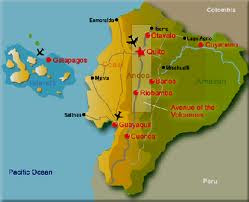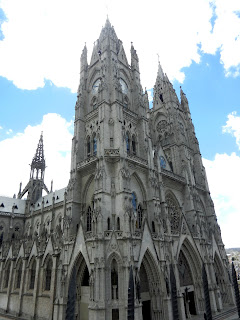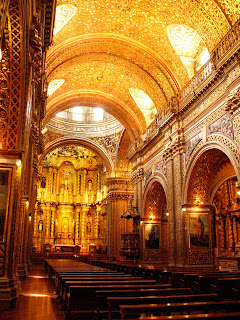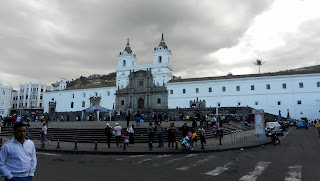At the center of town is the cathedral on one side of the small but charming Parque Bolivar, better-known as the Parque de las Iguanas, for obvious reasons.
Lots of urban iguanas live in the trees and hang out in the park.
Monos (literally "monkeys", as the city denizens are known: the story goes back to the 17th century and King Juan Carlos II of Spain. ) are quite proud of Malecón 2000, an ambitious Millennium project to refurbish the downtown riverfront. It is now a very pleasant (and safe) area to walk with open areas and attractions for the whole family. It begins at the Moorish clock tower (1931).
The biggest historical event to take place in the city occurred in 1822 when the two giants of South American liberation, Venezuelan Simón Bolívar and Argentine José de San Martín, met for the only time. This is commemorated with a statue along the Malecón.
The Galápagos are an intriguing destination for many
travelers. The star of many National
Geographic spreads and TV programs, they are known for exotic and unique
wildlife as well as the inspiration for Darwin’s revolutionary ideas on evolution.
After going to Easter Island, it seemed like an obvious place to visit on the
way back to the US.
In some ways, having spent time in Easter Island and New
Zealand helped prepare me for the visit. All three areas have been historically
quite isolated from the rest of humanity for many years. The Galápagos and NZ
were untouched by humans until recently, each became home to many unique and
unusual creatures, and both face severe threats to the native species from
introduced plant and animal species, including homo sapiens. New Zealand has suffered more extinction of species
because the contact started several hundred years ago and the land is much more
hospitable to new-comers. The lack of water in the Galápagos in particular has
limited permanent settlements until the 20th century. Easter Island
is a cautionary tale on how human inhabitation can have disastrous effects.
Most casual visitors to the islands, like me, will be
surprised by what they find. You might expect a more typically tropical climate as they
straddle the Equator, but the lowlands are more Arizona than Tahiti, with cacti
the dominant flora. The water is also surprisingly cold due to the frigid
Humboldt Current. Most snorkelers and surfers use a wetsuit for comfort. This
is also the reason that endemic penguins live here. (Note: They use the
term”endemic” to denote flora and fauna unique to the Galapagos,“native” for
those also found elsewhere, and “introduced” for the new-comers.)
The most unexpected thing may be that despite the
designation of the islands as a National Park, Marine Preserve, and UNESCO
World Heritage Site, it is NOT pristine and unspoiled.
Signs of development are obvious in many
places you will visit. The number of permanent residents and tourists have
exploded in the last 50 years. In the 1960’s there were 1,000 permanent
residents and 2,000 tourists a year: those numbers now are 30,000 residents and 200,000
visitors per year! This has led to stressful and contentious times
balancing the needs of the people and preserving the plants and wildlife. For those
interested, there is a well-written book about these struggles from the years
2000-2001 (Plundering Paradise : the hand of man on the Galápagos Islands by Michael D’Orso). Things have improved
since then, as there has been more communication between the National Park and
the citizens, but it is far from resolved. The people are better understanding that preserving the wildlife is in everyone’s
best interest, and the National Park is making it easier to transition between
activities like illegal sea cucumber fishing to tourist-based “artisanal” small fishing excursions. It has been a major
challenge for both sides.
What I came to appreciate was that man has had a profound
effect on the islands ever since they were first visited by the Spanish in the 16th
century, from taking hundreds of thousands of tortoises for food, to
introducing all kinds of pests. You cannot understand the place without
understanding this. If you learn about the human history of the Galápagos, you
find multiple tales of the struggle and
heartache people faced trying to live in this arid and hostile
environment. The Spanish have called the Galapagos “Las Islas Encantanta”, which travel agents have translated as “The
Enchanted Isles”, but might more accurately interpreted as “The Bewitched
Isles”. There has been a lot of bad mana
here, and ancient sailors felt and feared it.
 |
| The Casa Blanca Hotel |
The Galapagos are so-named because of the resemblance
between a sway-backed giant tortoise and a Spanish saddle, and is an archipelago
of 29 islands and islets 600 miles off the west coast of Ecuador and strewn
across 17,000 sq. miles of Pacific Ocean. Only four of the islands are inhabited,
and 97% of the land is uninhabited National Park land, but it feels like less
because most visitors spend much time on the 3%. We started on San Cristobal
for two nights. The accommodations, like the Casa Blanca in Puerto Baquerizo Moreno, were funky but comfortable,
kind of like Greece in the 1970’s.
Our days were quite active, with hiking, biking, kayaking,
and for me, snorkeling. Our first
afternoon was highlighted by a hike outside of town. Here is the bay where
Darwin’s Beagle first landed. Note
the arid landscape with endemic Candelabra and Giant Prickly Pear Cacti.
The third endemic cactus is the Lava Cactus, which we saw
later.
 |
| Lava Cactus |
Here is a statue of Chuck commemorating his visit.
Day 2 was highlighted by a trip to Kicker Rock, where hammerhead
sharks like to cruise, but the water was too murky, so I didn’t see any. I did get to
see plenty of other submarine creatures. Unfortunately for me I did not have an
underwater camera, but probably lucky for you since this blog would be 25%
longer with those photos. Underwater highlights included sea turtles, white-tipped sharks, and
diving sea iguanas.
 |
| Kicker Rock |
 |
| Pepo con Gringo |
After two days with Pepo, we took a tiny plane to Isabela,
where we were placed in the able hands of local resident Pablo, as passionate,
opinionated, and knowledgeable guide as I have ever had. The first day with
him we hiked through mud to the rim of Sierra Negra crater, said to be the
second largest on the planet. Sadly, it was fogged in, and we couldn’t see far,
but we saw a lot of smaller flora and fauna. Then next day we biked out to the Wall of Tears, so called because of the suffering of prisoners from this pointless construction
in the 1940’s and 50’s.
Puerto Villamil is Isabela's main town, laid back and dusty. The
large Catholic church is brightly decorated with this stirring painting of
Christ visiting the Galápagos with tortoises, iguanas, and the whole gang.
There are reminders everywhere that this land is volcanic, like this lava tube.
A harrowing 2.5 hour ferry trip across open ocean took us from Isabela to Santa Cruz. The most popular photo-op on the islands is found on a day trip to the tiny isle of Bartolomé, after
climbing to the top and looking across to the
volcanic landscape of Santiago Island.
Near the Charles Darwin Center on Santa Cruz you will find
another unique item, a statue honoring Guias
Naturalistas: the tour guides. I think it resembles Pablo. He says that is a
GPS in the right hand, but I suspect it is a cell phone.
That is all very nice, but you come here for the creatures.
When you first arrive, you think “I hope to see a giant tortoise, a sea iguana,
etc.” By day two, you realize they are all over the place. If you miss this one
there will be another around the corner. By reputation, most of the animals are
quite unafraid of people and the visitor can interact a lot with them. That may
be true, but the park is really emphasizing keeping a 6 foot perimeter from the
wildlife, so we had no super-close encounters.
To summarize major categories:
Sea lions- There are lots and lots of them. They go where
they want, act like they own the place, and frankly are a bit of a nuisance. We have lots of them in California,
so I wasn’t that interested and didn't bother with a lot of photos. They pups are cute, but aren't all babies? Sometimes they will frolic with snorkelers, but I did not experience that.
 |
| Sea lion trespassing |
Giant tortoises- They are the real deal: very big, very
slow, and not scarce, thanks in large part to heroic restoration efforts. You
see them at the breeding centers, on farms, and in the wild. Unfortunately for
them, their brain is the size of an apricot, and they are delicious by all
accounts.
 |
| Tortoise developement |
 |
| Tortoise embryo |
 |
| Juvenile eating yummy cactus |
 |
| Tortoise poop |
 |
| Adult |
 |
| Tortoise with friends (violating 6' perimeter rule) |
 |
| Hybrid genetic experiment gone terribly wrong!!! |
Other reptiles- #1 has to be the sea iguanas, remarkable
land/aquatic beings. They are all over the place, with the black bodies drying
out on the black lava rocks.
#2- There are also some very rare and endangered yellow land
iguanas.
#3- And don’t forget the humble endemic lava lizard.
Last but not least-Birds- I’m not a real birder, but with skilled guides pointing them out, you can’t help but be impressed with the opportunity to see so many species up close.( I did my best to correctly identify these, but don't take it to the bank. All these bird photos are mine except the vermillion flycatcher: my photo was from a car and only shows a tiny red spot.)
A favorite is the native Blue-Footed Booby, noted for bright blue feet, a comical (to non-boobies) mating ritual, and inspiration for thousands
of punny T-shirts (i.e.:" I ♥ Boobies").
 |
| BFB |
 |
| Nazca boobies, cousins of BFB |
 |
| Male frigate bird attempting to attract a mate |
 |
| Short-eared owl holding its ground mid-day |
 |
| Short-eared owl close-up |
 |
| Male Vermillion Flycatcher |
 |
| American Oystercatcher |
 |
| Galapagos Penguin- only penguin native to the Northern Hemisphere |
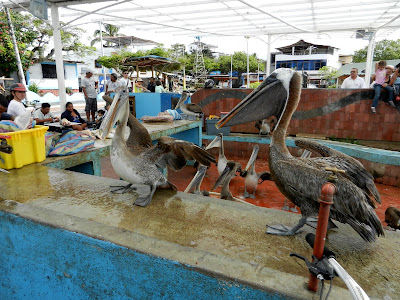 |
| Brown Pelicans enjoying shopping at Puerto Ayora fish market |
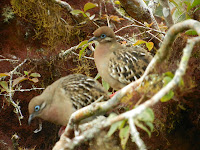 |
| Galapagos Doves |
 |
| Doves again |
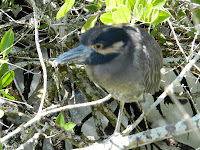 |
| Yellow-crowned Night Heron |
 |
| Brown Noddy |
 |
| Great Blue Heron |
 |
| Lava Gulls |
 |
| Ruddy Rockturner |
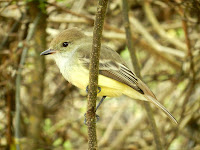 |
| Galapagos flycatcher |
 |
| Yellow warbler |
 |
| Pink Flamingos |
 |
| Semipalmated plover |
One of the most interesting is the Woodpecker finch, a rare tool-using bird that uses a twig or cactus spine it probe bugs from crevasses in bark. Thanks to Fayne's sharp eyes, we saw one in action. This picture is shortly after he dropped his twig.
 |
| Woodpecker finch |
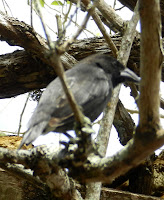 |
| Cactus finch? |
There are many, many finches all over, I have many photos, and Pablo tried patiently to point out the salient but subtle distinctions between the species, but I cannot claim to have mastered them.
 |
| Small Ground finches ? |
That's the best I can do to briefly summarize my 9 days, eight nights in the Galápagos. As an addendum to this blog, I will have some further observations and tips for others that might want to visit Ecuador and the Galápagoss.
Quito was the last stop of this adventure for three nights before finally returning home. Quito at an elevation of 9,350 feet is the world's second highest national capital.It's claims to fame include having a well-preserved 16th century colonial center (one of the first World Cultural Heritage Sites declared by UNESCO in 1978), and that is very near the equator. It houses Ecuador's best museum, Museo del Banco Central, which is modest by international standards. It is strongest with pre-Columbia pottery
The old town has several impressive churches, like the massive neo-Gothic National Basilica,
with it's uniquely South American gargoyle drains,
 |
| Armadillo gargoyles |
The statue sits on El Panecillo hill, can be visited on the hop-on-hop-off bus, and is big, bold, bizarre, and beautiful.
One of the most praised churches is La Compañía, the best example of a Spanish baroque architecture in the New World, with it's intricately-carved exterior
and gleaming gold-leaf interior.
My favorite church is the oldest, the Church of San Francisco, begun in 1524 on the site of an Inca palace when colonial Quito was founded.
The interior is solid, with thick columns supporting a Moorish-inspired ceiling.
A more secular tourist attraction is 22 miles north of town, the Mitad del Mundo, where you will visit an attracive monument marking the Equator.
Or does it? A few years ago, GPS data placed the real equator about a few hudred meters to the north. It now runs through a pre-existing tourist site, Museo de Sitio Intiñan, previously dedicated to helping people vicariously experiencing life in Amazonia, with shrunken heats, curare-laced blow darts, and statues of nearly naked natives,
 |
| Note G-string to prevent parasites from migration to the bladder |
I also found out later that all of the amazing powers displayed there (testing muscle strength, balancing an egg on a nail, and most convincing, the demonstration of the Coriolis effect on a tub of water on the equator and a few feet north and south) have all been repeatedly scientifically debunked. Oh, and BTW, the most recent GPS data shows this site is not truly on the equator either! (Where is that damned elusive Equator???)
One final tourist must-do is a is a trip up to the top of the Pichincha volcano looming over Quito via the TelefériQo, a gondola which takes you up to 13,000 feet. The view is literally breath-taking at that altitude, but a of coca tea.helps with soroche (altitude sickness).
It was time for it all to end, to come back home to face "reality" on a midnight flight to SFO via Miami. We were getting a bit tired, and like my camera, many travel staples (favorite clothes, suitcases, supplies) were all wearing out. We got back to California on Labor day, and were immediately engulfed in work, home, and family challenges. So this is the last chapter in "John & Fayne in New Zealand- Part II. I welcome all comments and questions, best done through blogspot, my Facebook page, or email. We probably will not be on any extensive adventures at least for a year. My camera needs replacement and I can get a bit long-winded, but trust me that I leave out more than I include, and it takes me more time than it should, but if there is significant interest in future travel-related blogs, please let me know and I'll keep it in mind. I have been very heartened and humbled by the positive feedback, so much thanks to all my readers.
Addendum- Below are some observation and tips on travel in Ecuador and the Galápagos, perhaps not of general interest, but helpful to those contemplating a visit.
The Galápagos-
If you are planning a trip to here, your first decision is a
land-based vs. a cruise-based tour. They both have pros and cons, some people
try to do a little of both. The cruise boats are small-to-medium sized, vary widely in quality,
and the schedule is quite regimented, but you may get to visit some places
off-limits to others. (There are only 140 sites in the park open to visitors,
of which 50% are open only to the cruise
ships). Beware if you are prone to sea-sickness, and the less costly cruises can
be noisy, cramped, and have poorer quality guides. Also, check the itinerary
carefully. A “7 day cruise” will have the first and last day on land, and will
mostly visit places you can access on land.
Land-based tours can offer you more flexibility, can let you
spend more time free of crowds, and will allow you to get a truer sense of both
sides of the islands, the people and the natural wonders. Whichever
way you go, you will spend significant time both on land and on the ocean. We
chose land-based (with Galakiwi), in part due to the suggestion of Deb and Terry Hendricks in
Fort Bragg, who visited about 7 years ago. The quality of guides is probably the most
important component to one’s visit. Ours guides Pepo and Pablo were both great, and made the trip. We talked to other less fortunate tourists.
Also, despite the fame of the islands, tourist facilities could use a major upgrade, particular for mobility-challenged visitors. Inter-island travel, either by tiny prop planes or small and potentially unsafe former fishing boat "ferries"are substandard. I was also surprised by the simple and not-too-informative information centers, like the Darwin Foundation. They deserve and would benefit from a world-class natural history museum (of the quality of the Monterey Bay Aquarium), and I hope some mega-rich philanthropist steps up to the plate.
Ecuador-
Pros- The official currency there is not the sucre, as I thought. When I arrived at the Guayaquil airport, I naively asked where to get some. I learned that since 2000 the official currency is.....the US dollar! They must have the largest collection of Sacagawea dollars anywhere, and for smaller coins they use a mix of US-minted and locally-made coins of the same size and shape. It is also very helpful that they use the same electrical plugs and current as the US, so no adapters or converters needed.
In general, things are quite cheap. The food is good, especially the seafood but the meat too, and inexpensive. As a South American country to visit, it has many of the same attractions as Peru (coast, Andes, Inca ruins, colonial cities, and the Amazon) plus the Galapagos but minus Cuzco and Machu Picchu, and is a good alternative.
Cons- Things are more run-down than I expected, especially the more prominent sites. The major museum in Quito is poorly maintained and not clearly marked. The grounds around the TelefériQo also shabby, with closed and abandoned shops.
Security is also a concern (but not in the Galapagos), probably similar to surrounding countries.
